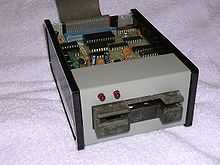Exatron Stringy Floppy

The Exatron Stringy Floppy (or ESF) is a continuous loop tape drive developed by Exatron.
The company introduced an S-100 stringy floppy drive at the 1978 West Coast Computer Faire, and a version for the Radio Shack TRS-80 in 1979. Exatron sold about 4,000 TRS-80 drives by August 1981 for $249.50 each, stating that it was "our best seller by far". The tape cartridge is about the size of a business card, but about 3⁄16 inch (4.8 millimetres) thick.[1] The magnetic tape itself is 1⁄16 inch (1.6 millimetres) wide.
According to Embedded Systems magazine the Exatron Stringy Floppy uses Manchester encoding, achieving 14K read-write speeds and the code controlling the device was developed by Li-Chen Wang (who also wrote a Tiny BASIC, the basis for the TRS-80 Model I Level I BASIC.)
In the July 1983 issue of COMPUTE!'s Gazette the ESF for the Commodore VIC-20 and the 64 was reviewed. The April 1983 issue of Creative Computing reviews the Winter CES show where Texas Instruments showed the TI Compact Computer 40 (CC-40) which included an optional peripheral, "a wafertape digital tape drive similar to the Exatron Stringy Floppy (US$139)."
Exatron pitched the ESF as "The viable alternative". The ESF was faster and more reliable than a data cassette, and half the price of a floppy disk.
Wafers were available with tape lengths ranging from 5 to 75 feet.[1] Known data capacities/tape length are: 4 KB/5 feet, 16 KB/20 feet, 48 KB/50 feet, and 64 KB/75 feet.[2]
See also
External links
- Exatron Stringy Floppy as described by Bill Fletcher
- Getting Files off Stringy Floppy Wafers for use in Emulators
- Advertisements
- Exatron Official Website
References
- ↑ 1.0 1.1 Barry, John (1981-08-31). "Stringy Floppy from Exatron". InfoWorld. pp. 47–48. Retrieved 15 February 2015.
- ↑ Reed, Matthew. "The Exatron Stringy Floppy". Retrieved 23 March 2014.
| ||||||||||||||||||||||||||||||||||||||||||||||